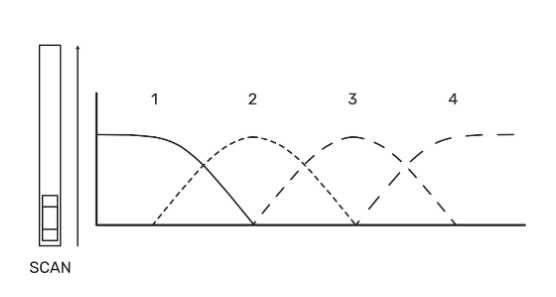DivKid and Vostok Instruments are bringing the joys of the Interpolating Scanner to Eurorack. First introduced 30 years ago by legendary engineer and analog sound hacker Jürgen Haible, the classic scanning circuit smoothly transitions between four input channels.
So, you’ve got your crossfader. And you’ve got your signal selectors. But have you truly scanned?
That’s the beautiful Interpolating Scanner circuit. Take four CV inputs, four audio inputs, or some combination, and then morph between them, driven by still more audio or CV. Jürgen Haible originated this circuit in 1994, with improvements by Donald Tillman in 1999. You can do more with this than you could even a cross-fader, because you can smoothly transition between points and even work with audio-rate morphing.
Waveform scanning to modulation morphing, it’s all there.
DivKid does a nice job explaining this:
The circuit morphs between the inputs, fading from one to the next as the voltage control rises. The Trace version of this classic circuit comes with a custom, fine-tuned slope response that prioritizes a smooth transition between the inputs, providing interesting middle points between the channels and improving its behavior when controlled by external CV signals.
From waveform morphing and CV-controlled transitions, to audio-rate scanning. Trace brings a new horizon of patching possibilities to any system.

Now the fact that you can get this in 4HP for US$130 (pre-tax), and this seems like an excuse to hunt down some space in any skiff. I haven’t gotten to test this yet, so I can’t speak to the “low noise” circuitry, but the design looks terrific.
Details from our friends Vostok in Barcelona:
FEATURES
- Four channels
- DC-Coupled inputs for use with both audio and CV signals.
- Custom fading slope designed to improve the response on middle positions.
- CV-controlled scanning with onboard attenuation and inversion of the modulation signal.
- Low noise analog VCA circuits.
SPECS
- Size: 4HP
- Current draw: +/-12V: 70mA, +5V: 0mA
- Depth: 32mm (including power cable)
- Input Impedance: 51kΩ (Signal inputs), 100kΩ (Scan CV input)
- Output Impedance: 1kΩ”
Product site:
https://www.vostokinstruments.com/trace
You’ll also find quite a lot of detail in the manual. Ben Wilson aka DivKid also contributes a ton of patch examples and extended notes – I wound up reading the whole manual, even without the unit, as it’s such a pleasure. You can use this to generate patterns, melodies, complex modulation, and even transforming tones into a complex oscillator.
The key here is really the behavior of the circuit across the four inputs. You can think of this as an array of four serial VCAs – in fact, you might have even patched something sort of like this manually at one time or another. I know I attempted something like this in software before, because it’s intuitively something you’d like to have. The analog circuit here, though, behaves in a unique and wonderful way. This image helps visualize this:

Sold! By the way, you can find more on Jurgen’s work and even an archive of his former personal site:
RANDOM*SOURCE has the original designs available for sale and detailed information. My understanding of the Vostok/DivKid design is that it’s inspired by the original, but its own design.
Here’s the archive of his original site:
Trace is coming soon. It looks like a fantastic gateway to the mixing and VCA and signal mucking goodness from Vostok.